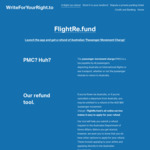Mod 31/3/21: See comments. Business is closed down, don't click through, it's now a parked domain. See linked comment for more information.
I'm a consumer-rights fanatic and, as a flying enthusiast, nothing gets me more fired up than a flying-related consumer rights issue.
I've recently been swotting up on the AUD $60 'passenger movement charge' that the Australian government charges travelers departing Australia. I wanted to explain what I've learned. Fair warning, this post is about as long as boarding on a full A380.
I've set up a service to help folks who are entitled to a refund to make their claim. I'm offering Ozbargain members 40% off our fee to lodge and process the refund application - just pop a note in the webform or send us an email, and we'll apply the reduced fee when we pay out your claim.
You can make your own claim, but we try to:
- simplify the process - we know how to set out your claim, and how to respond when the the first answer is 'no';
- cut the cost of receiving your refund - our fees are lower than the administration fees charged by airlines, and we can usually pay claims out in your currency - saving you hefty bank transfer fees.
Passenger Movement Charge is refundable in a whole bunch of situations. Here are a few:
- If the departure did not take place - this is usually the simplest claim to get approved.
- If a child under 12 years old was mistakenly booked on an adult ticket and Passenger Movement Charge was paid. (In fact, Airasia accidentally did this for years until a smart cookie in Darwin caught on.)
- If you are a transit passenger. These claims can get quite complicated, so airlines may be reluctant to issue a refund.
You can apply to some airlines directly - but policies vary and fees often apply
- In general, you can apply directly to your airline for a refund of passenger movement charge. However, many airlines charge (or reserve the right to charge) hefty administration fees. For example, Jetstar's fee is $50 (an eye-watering 83% of your refund).
- Some airlines are willing to process straightforward refund claims for free. Air New Zealand have advised that they do not charge an administration fee. If your airline is one of the few that will do it for free, then this will generally be your best option! Plus, you may also be able to get other fees back too.
- You may have some difficulty persuading customer service representatives from some airlines that you are entitled to a refund, or the representative may not understand that Passenger Movement Charge is refundable even on a non-refundable base fare. Singapore Airlines is one such airline, having told us that it is unable to issue refunds of Passenger Movement Charge on a non-refundable fare.
Also, you can do it yourself - it just takes time, and the patience to follow up if the Government ignores your email.
- The Australian Government says on their website that "A request for refund should be made directly from the carrier."
- It's (kind of) a lie. Regulation 6 of the Passenger Movement Charge Collection (Recovery and Refund of Charges) Regulation 2013 says a person entitled to a refund can apply directly to the Aussie Government for a refund.
- We sent a bunch of emails to the Department of Home Affairs arguing this point, and they eventually conceded (begrudgingly AF) that "the Department of Home Affairs can also consider applications for a refund of PMC."
If you've made it this far… well, you probably need a beer. Instead, here's an explanation of the meaning of 'transit passenger' - if you're minded to really have a fight.
- The approach that the Australian Government - and most airlines' booking software - seems to take is that a passenger who transits on a single booking via Australia and stays airside (i.e does not clear immigration) is not required to pay Passenger Movement Charge.
- Despite this, many airlines' booking software will levy Passenger Movement Charge where an airside transit occurs across two calendar days. (e.g. fly AKL-MEL and land at 23.30, then leave MEL for SIN at 01.30, two hours later but on a different calendar day).
- Also, airside-only transits made up of two separate tickets (either on one airline or two) will usually attract Passenger Movement Charge in the airline booking software because the system is unable to take the separate booking for the incoming flight into account when deciding whether or not to charge Passenger Movement Charge.
- Further, landside transits are potentially within the meaning of 'transit passenger'. This point does not appear to have been tested to date, but we are very eager to try it out.
Landside transits
- Airlines, and (as far as we know) the Australian Government, seem to take the view that a person who transits landside is not a transit passenger.
- However, "transit passenger" is a defined term in s 3 of the Passenger Movement Charge Collection Act 1978. A person is only a "transit passenger" when they have been "immigration cleared within the meaning of section 172 of the Migration Act 1958".
- A person who enters Australia at a "port" (which includes an airport) is immigration cleared "if, and only if" the person leaves the port (s 172(1)(a)(iii)).
Section of the Migration Act 1958 says a port means either a "proclaimed port" or a "proclaimed airport". - A "proclaimed port" means (within mainland 'oz, not the external territories) "an airport appointed under section 15 of the Customs Act 1901"
- Under s 15(1)(b), " the Comptroller‑General of Customs may, by notice published in the Gazette… appoint airports and fix the limits of those airports."
- The limits fixed for the airports appointed by notice in the Gazette tend to be pretty expansive, often extending beyond the airport's carparks. In all of the cases we have reviewed, the legal boundaries of the airport include the terminal buildings.
- This means (perhaps we should say 'arguably means', even though we're pretty confident) that a person has not left the port for the purposes of s 172(1)(a)(iii) of the Migration Act 1958 if they've only passed through immigration within the terminal, but have not actually left the airport building.
- If the person then leaves Australia without leaving the airport, they will have completed their departure from Australia without having (technically) been 'immigration cleared', and would therefore be a transit passenger.
- Which means, of course, that they'd be entitled to a refund of their sixty bucks.


So how much is your fee compared to what they get back and how long does it take to get money back